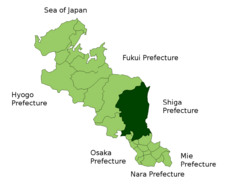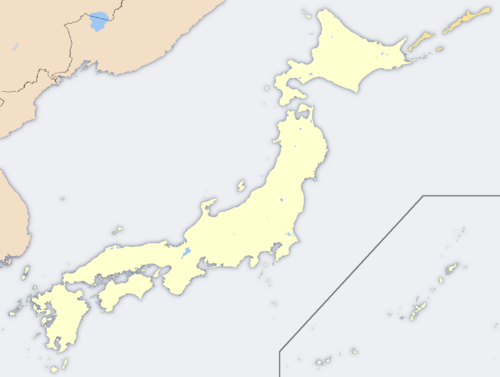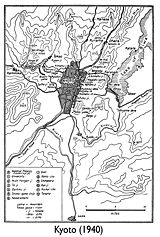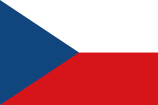Kyoto
 Kyoto's location in Kyoto Prefecture, Japan. |
|
 Kyoto's location in Japan. |
|
| Location | |
| Country | Japan |
| Region | Kansai |
| Prefecture | Kyoto Prefecture |
| Physical characteristics | |
| Area | 827.90 km2 (319.65 sq mi) |
| Population (as of April 2008) | |
| Total | 1,473,873 |
| Density | 1,779 /km² (4,608 /sq mi) |
| Location | |
| Symbols | |
| Tree | Weeping Willow, katsura |
| Flower | Camellia, Azalea, Sugar Cherry |
 Flag |
|
| Kyoto Government Office | |
| Mayor | Daisaku Kadokawa |
| Address | 488 Teramachi-oike, Nakagyō-ku, Kyōto-shi, Kyōto-fu 604-8571 |
| Phone number | 075-222-3111 |
| Official website: City of Kyoto | |
Kyoto (京都 Kyōto?) (IPA /kʲoːto / listen is a city in the central part of the island of Honshū, Japan. It has a population close to 1.5 million. Formerly the imperial capital of Japan, it is now the capital of Kyoto Prefecture, as well as a major part of the Osaka-Kobe-Kyoto metropolitan area.
Contents |
History

Although archaeological evidence places the first human settlement on the islands of Japan to approximately 10,000 BC, relatively little is known about human activity in the area before the 6th century AD. During the 8th century, when the powerful Buddhist clergy became involved in the affairs of the Imperial government, the Emperor chose to relocate the capital to a region far from the Buddhist influence. Emperor Kammu selected the village of Uda, at the time in the Kadono district of Yamashiro Province, for this honor.[1]
The new city, Heian-kyō (平安京 "tranquility and peace capital"), became the seat of Japan's imperial court in 794, beginning the Heian period of Japanese history. In Japanese, the city has been called Kyo (京), Miyako (都) or Kyo no Miyako (京の都). In the 11th century, the city was renamed Kyoto ("capital city").[2] Kyoto remained Japan's capital until the transfer of the government to Edo in 1868 at the time of the Imperial Restoration. (Some believe that it is still a legal capital: see Capital of Japan.) After Edo was renamed Tokyo (meaning "Eastern Capital"), Kyoto was known for a short time as Saikyo (西京 Saikyō, meaning "Western Capital").
An obsolete spelling for the city's name is Kioto; it was formerly known to the West as Meaco or Miako (Japanese: 都; miyako, meaning "the seat of Imperial palace" or "capital".). Another term commonly used to refer to the city in the pre-modern period was Keishi (京師), meaning "metropolis" or "capital".

The city suffered extensive destruction in the Ōnin War of 1467-1477, and did not really recover until the mid-16th century. Battles between samurai factions spilled into the streets, and came to involve the court nobility (kuge) and religious factions as well. Nobles' mansions were transformed into fortresses, deep trenches dug throughout the city for defense and as firebreaks, and numerous buildings burned. The city has not seen such widespread destruction since. There was some consideration by the United States of targeting Kyoto with an atomic bomb at the end of World War II because, as an intellectual center of Japan, it had a population "better able to appreciate the significance of the weapon." [3]In the end it was decided to remove the city from the list of targets due to the insistence of Henry L. Stimson, Secretary of War in the Roosevelt and Truman administrations. The city was largely spared from conventional bombing as well, although small-scale air raids did result in casualties.
As a result, Kyoto is one of the few Japanese cities that still has an abundance of prewar buildings, such as the traditional townhouses known as machiya. However, modernization is continually breaking down the traditional Kyoto in favor of newer architecture, such as the Kyoto Station complex.
Kyoto became a city designated by government ordinance on September 1, 1956. In 1997, Kyoto hosted the conference that resulted in the protocol on greenhouse gas emissions that bears the city's name.
Geography

| Historic Monuments of Ancient Kyoto (Kyoto, Uji and Otsu Cities)* | |
|---|---|
| UNESCO World Heritage Site | |
| State Party | |
| Type | Cultural |
| Criteria | ii, iv |
| Reference | 688 |
| Region** | Asia-Pacific |
| Inscription history | |
| Inscription | 1994 (18th Session) |
| * Name as inscribed on World Heritage List. ** Region as classified by UNESCO. |
|
Kyoto is located in a valley, part of the Yamashiro (or Kyoto) Basin, in the eastern part of the mountainous region known as the Tamba highlands. The Yamashiro Basin is surrounded on three sides by mountains known as Higashiyama, Kitayama and Nishiyama, with a height just above 1000 meters above sea level. This interior positioning results in hot summers and cold winters. There are three rivers in the basin, the Ujigawa to the south, the Katsuragawa to the west, and the Kamogawa to the east. Kyoto City takes up 1.9% of the land in the prefecture with an area of 827.9 km².
The original city was arranged in accordance with traditional Chinese geomancy following the model of the ancient Chinese capital of Chang'an (present-day Xi'an). The Imperial Palace faced south, resulting in Ukyō (the right sector of the capital) being on the west while Sakyō (the left sector) is on the east. The streets in the modern-day wards of Nakagyō, Shimogyō, and Kamigyō still follow a grid pattern.
Today, the main business district is located to the south of the old Imperial Palace, with the less-populated northern area retaining a far greener feel. Surrounding areas do not follow the same grid pattern as the center of the city, though streets throughout Kyoto share the distinction of having names.
Kyoto sits atop a large natural water table that provides the city with ample freshwater wells. Due to large scale urbanization, the amount of rain draining into the table is dwindling and wells across the area are drying at an increasing rate.
Politics and government
The directly elected executive mayor in Kyoto as of 2008 is Daisaku Kadokawa, an independent supported by the Liberal Democratic Party. The legislative city assembly has 68 elected members.
Elections
- Kyoto mayoral election, 2008
Wards



Kyoto has eleven wards. They are (colors from the map above)
- Fushimi-ku (伏見区) - orange
- Higashiyama-ku (東山区) - pink
- Kamigyo-ku (上京区) - dark blue
- Kita-ku (北区) - light blue
- Minami-ku (南区) - light green
- Nakagyo-ku (中京区) - yellow
- Nishikyo-ku (西京区) - forest green
- Sakyo-ku (左京区) - olive green
- Shimogyo-ku (下京区) - red
- Ukyo-ku (右京区) - brown
- Yamashina-ku (山科区) - purple
Together, they comprise the city of Kyoto. Like other cities in Japan, Kyoto has a single mayor and a city council.
Culture
Although ravaged by wars, fires, and earthquakes during its eleven centuries as the imperial capital, Kyoto was spared from the firebombing of World War II. With its 2000 Buddhist temples and Shinto shrines, as well as palaces, gardens and architecture intact, it is one of the best preserved cities in Japan. Among the most famous temples in Japan are Kiyomizu-dera, a magnificent wooden temple supported by pillars off the slope of a mountain; Kinkaku-ji, the Temple of the Golden Pavilion; Ginkaku-ji, the Temple of the Silver Pavilion; and Ryōan-ji, famous for its rock garden. The Heian Jingū is a Shinto shrine, built in 1895, celebrating the Imperial family and commemorating the first and last emperors to reside in Kyoto. Three special sites have connections to the imperial family: the Kyoto Gyoen area including the Kyoto Imperial Palace and Sento Imperial Palace, homes of the Emperors of Japan for many centuries; Katsura Imperial Villa, one of the nation's finest architectural treasures; and Shugaku-in Imperial Villa, one of its best Japanese gardens.
Other notable sites in Kyoto include Arashiyama and its picturesque lake, the Gion and Pontochō geisha quarters, the Philosopher's Walk, and the canals which line some of the older streets.


The "Historic Monuments of Ancient Kyoto" are listed by the UNESCO as a World Heritage Site. These include the Kamo Shrines (Kami and Shimo), Kyō-ō-Gokokuji (Tō-ji), Kiyomizu-dera, Daigo-ji, Ninna-ji, Saihō-ji (Kokedera), Tenryū-ji, Rokuon-ji (Kinkaku-ji), Jishō-ji (Ginkaku-ji), Ryōan-ji, Hongan-ji, Kōzan-ji and the Nijo Castle, primarily built by the Tokugawa shoguns. Other sites outside the city are also on the list.
Kyoto is renowned for its abundance of delicious Japanese foods and cuisine. The special circumstances of Kyoto as a city away from the sea and home to many Buddhist temples resulted in the development of a variety of vegetables peculiar to the Kyoto area (kyōyasai 京野菜).
Japan's television and film industry has its center in Kyoto. Many jidaigeki, action films featuring samurai, were shot at Toei Uzumasa Eigamura[1]. A film set and theme park in one, Eigamura features replicas of traditional Japanese buildings which are used for jidaigeki. Among the sets are a replica of the old Nihonbashi (the bridge at the entry to Edo), a traditional courthouse, a Meiji Period police box and part of the former Yoshiwara red-light district. Actual film shooting takes place occasionally, and visitors are welcome to observe the action.
Kyoto International Manga Museum is also situated in Kyoto. For an entrance fee visitors are able to view exhibitions and read as much manga as they desire. It is trying to acquire every manga ever published and so far houses approximately 200,000 titles.
Economy


Tourism forms a large base of Kyoto's economy. The city's cultural heritages are constantly visited by school groups from across Japan, and many foreign tourists also stop in Kyoto. In 2007, the city government announced that a record number of tourists had visited Kyoto for the sixth year in a row [4], and it was chosen as the second most beautiful city in Japan, in a regional brand survey.[5]
The city's industry consists mainly of small plants, most of which are run by artisans who produce traditional Japanese crafts. Kyoto's kimono weavers are particularly renowned, and the city remains the premier center of kimono manufacturing. Such businesses, vibrant in past centuries, have declined in recent years as sales of traditional goods stagnate.
Kyoto's only sizable heavy industry is electronics: the city is home to the headquarters of Nintendo, OMRON, Kyocera, and Murata Machinery. The apparel giant Wacoal also operates in Kyoto. However, the growth of high-tech industry has not outpaced the decline in traditional industry, and as a result, Kyoto's total output has declined relative to other cities in Japan.
Colleges and universities

Home to thirty-seven institutions of higher education, Kyoto is one of the academic centers of the country. Kyoto University, one of Japan's national universities, is considered to be one of the top universities in Japan, with several Nobel laureates, for example Yukawa Hideki. The Kyoto Institute of Technology is also among the most famous universities in Japan, and is considered to be one of the best universities for architecture and design in the country.
Kyoto also has a unique higher education network called the Consortium of Universities in Kyoto, which consists of three national, five public (prefectural and municipal), and 41 private universities, as well as the city and four other organizations. The consortium does not offer a degree, but offers the courses as part of a degree at participating universities.[6]
As well as more than 30 Japanese universities and colleges, American universities also find the city as an important city of education and research. Kyoto Consortium for Japanese Studies (KCJS) is a consortium of 14 American universities that sponsors a rigorous, two-semester academic program for undergraduates who wish to do advanced work in Japanese language and cultural studies. In addition, Stanford University has its own Japan Center in Kyoto. [7]
Transportation
- See also: Transportation in Greater Osaka





Kyoto Station is the center for transportation in the city. The second-largest in Japan, it houses a shopping mall, hotel, movie theater, Isetan department store, and several local government facilities under one fifteen-story roof. The Tōkaidō Shinkansen Line (see below) as well as all local rail lines connect here. Buses operating on routes within the city, the region, and the nation stop here as well.
There are also frequent services on JR West, Keihan, Hankyu, Kintetsu, and other rail networks to other cities in the Kansai region. JR West and Kintetsu connect at Kyoto Station. Hankyu has a terminal at the intersection of Shijō Kawaramachi, Kyoto's most thriving shopping and amusement district. Keihan has a terminal at Sanjō Keihan Station which is not far from Shijō Kawaramachi.
The Kyoto Municipal Transportation Bureau operates Kyoto's subway and bus system. The city operates two subway lines: Karasuma Line and Tōzai Line. The Karasuma Line runs beneath north-south Karasuma Street and links to Hankyu trains running beneath Shijō Street at the intersection of Shijō Karasuma, Kyoto's central business district, to the west of Shijō Kawaramachi. The Tōzai Line runs beneath east-west Oike Street and connects to Keihan at Sanjō Keihan and to JR at Nijō Station. The two subway lines meet at Karasuma Oike Station.
Access to Kyoto
From Kansai Airport and Itami Airport in Osaka
- See also: Kansai International Airport and Itami Airport
Although Kyoto does not have its own airport, you can get to the city via Kansai International Airport and Itami Airport in Osaka. The Haruka Express operated by JR West carries passengers from Kansai Airport to Kyoto Station in 73 minutes.
JR-WEST: Travel Information > Access to Kansai Airport
Osaka Airport Transport buses connect Itami Airport and Kyoto Station Hachijo Exit in an hour and cost 1,280 yen for a one-way trip. Some buses go further, make stops at major hotels and intersections in downtown, and get to Nijō Station or the Westin Miyako Hotel Kyoto near Keage Station of Municipal Subway Tozai Line.
Osaka Airport Limousine Timetable: Airport -> Kyoto Timetable: Kyoto -> Airport Terminal Guide
Tokaido-San'yo Shinkansen
- See also: JR Central, Tōkaidō Shinkansen, and San'yo Shinkansen
The Tōkaidō Shinkansen operated by JR Central provides passenger rail service linking Kyoto with Nagoya, Yokohama and Tokyo to the east of Kyoto and with nearby Osaka and points west on the San'yo Shinkansen, such as Kobe, Okayama, Hiroshima, Kitakyushu and Fukuoka. The trip from Tokyo takes about two hours and twenty-two minutes. From Hakata in Fukuoka, Nozomi takes you to Kyoto in just over three hours. All trains including Nozomi stop at Kyoto Station, serving as a gateway to not only Kyoto Prefecture but also northeast Osaka, south Shiga and north Nara.
Buses
Kyoto's municipal bus network is extensive. Private carriers also operate within the city. Many tourists join commuters on the public buses, or take taxis or tour buses. Kyoto's buses have announcements in English and electronic signs with stops written in the Latin alphabet.
Most city buses have a fixed fare, but a one-day bus pass and a combined unlimited train and bus pass are also available. These are especially useful for visiting many different points of interest within Kyoto. The bus information center just outside the central station handles tickets and passes. The municipal transport company publishes a very useful leaflet called "Bus Navi." It contains a route map for the bus lines to most sights and fare information. This too is available at the information center in front of the main station.
In addition to Kyoto Station, you can transfer buses at the intersections of Shijō Kawaramachi and Sanjō Keihan. The intersection of Karasuma Kitaōji to the north of downtown has a major bus terminal serving passengers who take the Karasuma Line running beneath Karasuma Street, Kyoto's main north-south street.
Cycling
Cycling forms a very important form of personal transportation in the city, to an extent that bicycle culture forms a part of Kyoto's urban identity. The geography and scale of the city are such that the city may be easily navigated on a bicycle.
Tourism
The UNESCO World Heritage Site
- See also: Historic Monuments of Ancient Kyoto (Kyoto, Uji and Otsu Cities)
About 20% of Japan's National Treasures and 14% of Important Cultural Properties exist in the city proper. The UNESCO World Heritage Site Historic Monuments of Ancient Kyoto (Kyoto, Uji and Otsu Cities) includes 17 locations in Kyoto, Uji in Kyoto Prefecture and Ōtsu in Shiga Prefecture. The site has been designated as World Heritage in 1994.
Iwatayama monkey park
Arashiyama Monkey Park Iwatayama (嵐山モンキーパークいわたやま?) in Nishikyō-ku is a park where monkeys roam freely. Visitors may pet them, feed them, walk amongst the wild monkeys. The park itself is inhabited by a troupe of over 170 Japanese macaque monkeys. After paying admission, one walks up a steep hill, at the top of which is an enclosure where visitors may go in and safely feed the monkeys. As there are no fences, the monkeys can come and go as they please, but they are especially tempted by food such as apples or peanuts. Even though the animals are wild, they have become accustomed to humans, and so are not afraid to come close to tourists bearing food.
Museums and Gardens




|
Festivals

Major festivals punctuate Kyoto's calendar. The first is the Aoi Matsuri on May 15. Two months later (July 14 to 17) is the Gion Matsuri, culminating in a massive parade. Kyoto marks the Bon Festival with the Gozan Okuribi, lighting fires on mountains to guide the spirits home (August 16). The October 22 Jidai Matsuri, Festival of the Ages, celebrates Kyoto's illustrious past.
Sports
Football
In football (soccer), Kyoto is represented by Kyoto Sanga F.C. who rose to J. League's Division 1 in 2005. Kyoto Sanga has a long history as an amateur non-company club, although it was only with the advent of professionalization that it was able to compete in the Japanese top division.
Amateur football clubs such as F.C. Kyoto BAMB 1993 and Kyoto Shiko Club (both breakaway factions of the original Kyoto Shiko club that became Kyoto Sanga) as well as unrelated AS Laranja Kyoto compete in the regional Kansai football league.
Baseball
With the popularity of the nearby Hanshin Tigers, Kyoto has never had a team in Nippon Professional Baseball, though the Tigers play several neutral-site games at Kyoto's Nishikyogoku Athletic Stadium every year.
Additionally, Kyoto's high school baseball teams are strong, with Heian and Toba in particular making strong showings recently at the annual tournament held in Koshien Stadium, Nishinomiya, near Osaka.
Sister cities
 Boston, United States
Boston, United States Paris, France (Friendship Pledge city)
Paris, France (Friendship Pledge city) Cologne, Germany
Cologne, Germany Prague, Czech Republic
Prague, Czech Republic Florence, Italy
Florence, Italy Kiev, Ukraine
Kiev, Ukraine Xi'an, People's Republic of China (Friendship city)
Xi'an, People's Republic of China (Friendship city) Guadalajara, Mexico
Guadalajara, Mexico Zagreb, Croatia
Zagreb, Croatia
Reference: Sister and Other Associated Cities, Kyoto's official web site.
Notes
- ↑ Kyoto Exhibitors' Association (1910) Kyoto Kyoto Exhibitors' Association of the Japan-British exhibition, Kyoto, p. 3 OCLC 1244391
- ↑ Lowe, John. (2000). Old Kyoto: A short Social History, p. x.
- ↑ Wyden, Peter. (1984). Day One: Before Hiroshima and After, page 196.
- ↑ Kyoto tourism setting new record for 6th year in a row - Japan News Review
- ↑ Sapporo picked as "most attractive town" for 2nd consecutive year - J-Cast
- ↑ http://www.consortium.or.jp/english/index.html
- ↑ Stanford Japan Center
References
- Lone, John. (2000). Old Kyoto: A Short Social History. Oxford: Oxford University Press. ISBN 0-19-590940-2.
- Ponsonby-Fane, Richard A. B. (1956). Kyoto: The Old Capital of Japan, 794–1869. Kyoto: The Ponsonby Memorial Society.
- Stewart, Harold. (1981). By the Old Walls of Kyoto: A Year's Cycle of Landscape Poems with Prose Commentaries. New York: Weatherhill. ISBN 083480154X.
- Titsingh, Isaac. (1834). [Siyun-sai Rin-siyo/Hayashi Gahō, 1652], Nipon o daï itsi ran; ou, Annales des empereurs du Japon. Paris: Oriental Translation Fund of Great Britain and Ireland. ...Click link for digitized, full-text copy of this book (in French)
- Wyden, Peter. (1984). Day One: Before Hiroshima and After. Simon & Schuster, Inc. ISBN 0-671-46142-7.
See also
- List of Shinto shrines in Kyoto
- List of Kyoto's Buddhist Temples
- List of Kyoto's Bridges
- List of Kyoto's Fires
External links
- Kyoto travel guide from Wikitravel
- Official site of Kyoto City (English)
- Kyoto—Guide including interactive map & over 1,200 pictures.
- Kyoto Podcast
- Kyoto's temples & shrines—Photos and cultural info on over 50 temples and shrines in Kyoto
- Kyoto's temples & shrines—Detailed explanation of selected 26 temples and shrines with photos in Kyoto
|
|||
| Cities | |||
|---|---|---|---|
| Ayabe | Fukuchiyama | Jōyō | Kameoka | Kizugawa | Kyōtanabe | Kyōtango | Kyoto | Maizuru | Miyazu | Mukō | Nagaokakyō | Nantan | Uji | Yawata | |||
| Districts | |||
| Funai | Kuse | Otokuni | Sōraku | Tsuzuki | Yosa | |||
|
|
|||||||||||
|
|||||||
|
||||||||||